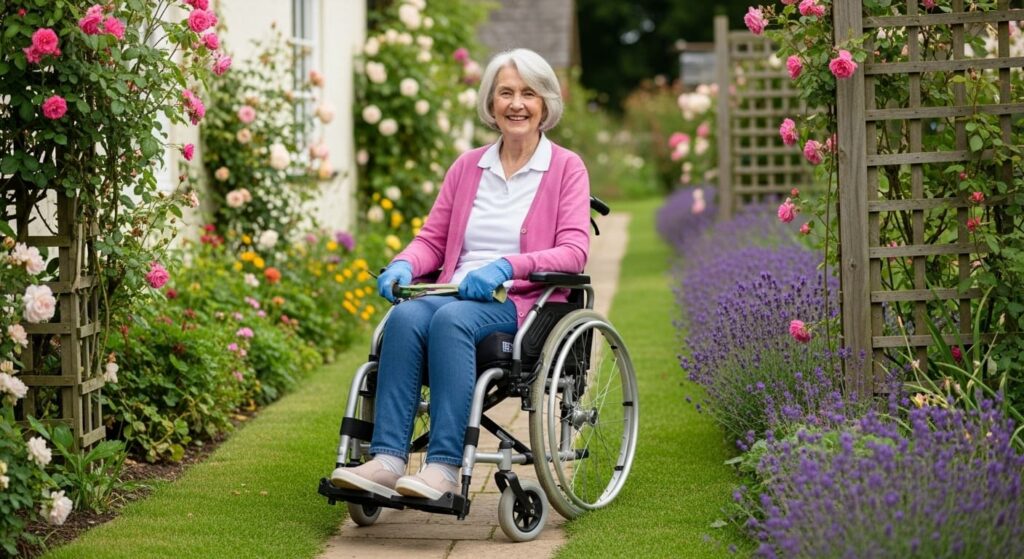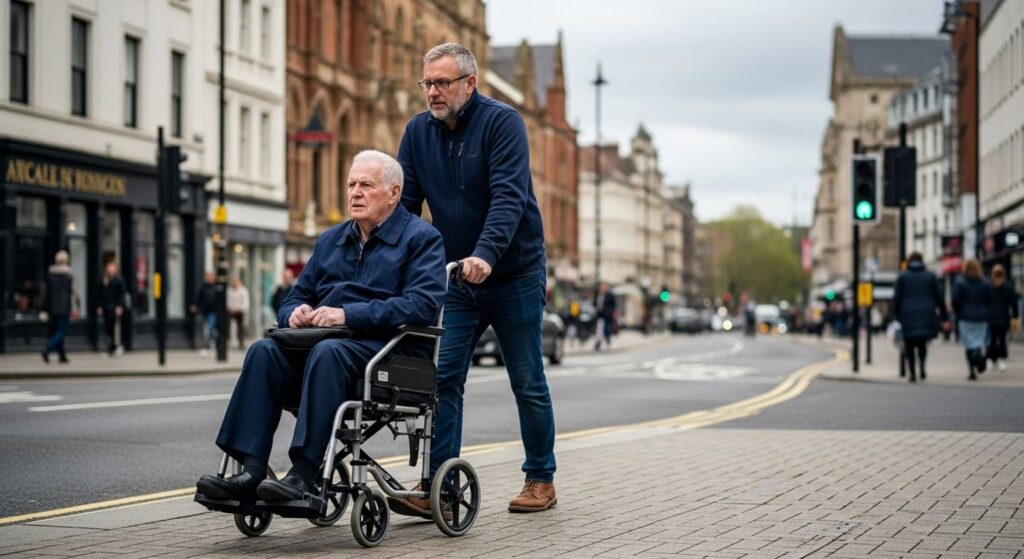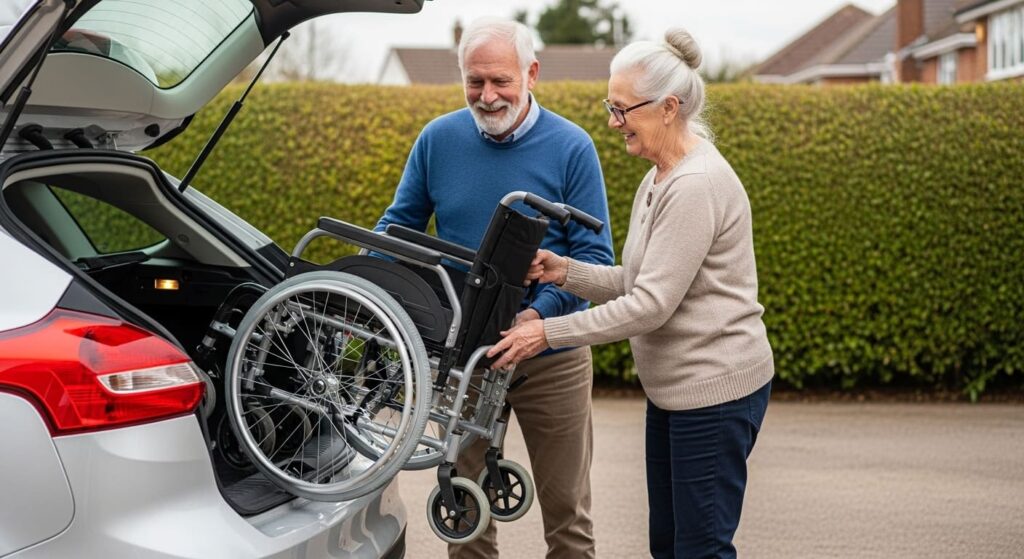Choosing Your First Manual Wheelchair
Choosing your first manual wheelchair is overwhelming. With 1.2 million UK wheelchair users and demand up 6.9% year on year, you’re surrounded by confusing options, many types, features and prices and it’s hard to know where to start - especially if you’re supporting a loved one or navigating mobility challenges for the first time.
Get it wrong and you’ll waste money on an uncomfortable wheelchair that gathers dust. Wrong sizing causes pressure sores. Poor transport keeps you at home. Cheap models break quickly and cost more long term.
At Mobility Shop, our 29 years of experience help you choose perfectly. We offer professional sizing, VAT exemption for eligible people, price match promise. From lightweight self-propelled models to transit wheelchairs, we’ll find your perfect match with next-day delivery.

Note: All our manual wheelchairs are VAT exempt for eligible customers, saving you 20% on your purchase.
Your Mobility Needs
Before we get into wheelchair specs, you need to honestly assess your individual needs. Every person’s situation is unique and the “best” wheelchair is the one that fits your specific circumstances.
Your Physical Capabilities
Consider your upper body strength and range of motion. Can you propel yourself independently or will you be relying on a carer to push you? Do you need a self-propelled wheelchair (with large rear wheels you can grip) or a transit wheelchair (designed to be pushed by someone else)?
If you have limited grip strength or shoulder mobility, self-propulsion may be tough at first but can improve with practice and the right wheelchair setup.
Your Daily Activities
Think about where and how you’ll use your wheelchair most often. Will you be using it indoors, outdoors or both? Indoor use requires better manoeuvrability in tight spaces, whilst outdoor use demands durability and can handle different terrains.
Types of Manual Wheelchairs
Knowing the main types of manual wheelchairs will help you make a more informed decision.
Self-Propelled Wheelchairs
Self-propelled wheelchairs have large rear wheels (20-26 inches) with hand rims to allow you to propel yourself. These wheelchairs offer independence and control, perfect for users with sufficient upper body strength.
We have:
- Days Healthcare Escape Lite - Ultra-lightweight at 11.8kg, for active users
- Roma Medical RMA1050 - Robust self-propelled wheelchair with puncture-proof tyres
- Karma Ergo 3 - Premium lightweight at 13.8kg

Transit Wheelchairs
Transit wheelchairs have 4 small wheels (usually 8-12 inches) and are designed to be pushed by a carer. These wheelchairs are more lightweight, streamlined and easier to carry or store than self-propelled versions.
Recommended transit wheelchairs:
- Drive Medical Enigma Spirit - Ultra compact folding transit chair 10.2kg
- Days Healthcare Escape Lite Transit - Attendant propelled version of our popular model
- Z-Tec Folding Transit - An affordable option that doesn’t compromise on sturdy construction.
These wheelchairs are for users who cannot self-propel due to limited upper body strength, cognitive issues or those who want to conserve energy for other activities. These models are for infrequent use or as a secondary wheelchair for added flexibility.
Lightweight Wheelchairs
Lightweight wheelchairs weigh between 10-14kg compared to 14-20kg for standard models. They use materials like aluminium or titanium to reduce weight without sacrificing strength.
The reduced weight makes these wheelchairs easier to propel, transfer and transport. They are perfect for users who need to lift their wheelchair into a car boot or for carers who frequently need to move the wheelchair.
"Sarah, 67, from Manchester, wanted a basic transit wheelchair for shopping trips. Our assessment showed she had sufficient upper body strength to self-propel and would benefit from independence. She chose a lightweight self-propelled model and now uses it daily for garden maintenance and local trips."
Heavy Duty and Bariatric Wheelchairs
Designed for users over 18 stone (250lbs), bariatric wheelchairs have reinforced frames, wider seats and stronger components. They support up to 35 stone (500lbs) or more.
We have:
- Roma Medical RMA1470 - Heavy duty wheelchair up to 30 stone (190kg)
- Drive Medical Sentra EC - Extra-wide bariatric chair with removable arms
- Days Healthcare Bariatric Transit - Attendant propelled option for larger users
These wheelchairs don't just accommodate larger users - they provide the comfort and safety that comes with proper sizing. Using the right-sized wheelchair prevents discomfort and reduces the risk of pressure sores. All our bariatric wheelchairs CE certified for safety and durability.
NHS Funding and Financial Support
Many customers don’t realise they may be entitled to NHS funding for their wheelchair. The NHS Wheelchair Service provides manual wheelchairs to eligible patients who have a long-term mobility need.
NHS Support
Speak with your GP or an occupational therapist to be referred to your area’s NHS Wheelchair Service. Assessment usually takes 6-8 weeks, and you will receive a wheelchair suitable for your assessed needs.
But NHS wheelchairs are basic models. For specialised features, lighter frames or greater comfort, private purchase may be the better route, especially if you're eligible for reimbursement.
Key Features to Consider
After you’ve got the basics, it’s time to look at key features that will affect your everyday comfort and convenience.
Seat Width and Depth
Seat size is key to comfort and health. You want enough width so you’re not squished against the armrests, but not so wide you slide around. Typically 1-2 inches on each side of your hips.
You want the seat to be deep enough for you to sit comfortably against the backrest, but with a small gap, 2- 3 inches between the seat edge and the back of your knees.
Armrests and Footrests
Armrests provide support and aid transfers, but add width to your wheelchair. Removable or flip-back armrests are good for sideways transfers, fixed armrests provide more structural support.
Footrests should have your knees at 90 degrees, with your feet flat on the footplates. Elevating leg rests are good for users with circulation issues or swelling, swing-away footrests make transfers easier.
Cushions and Comfort
Don’t underestimate the importance of a good cushion. Even if you’re only using your wheelchair occasionally, proper cushioning prevents pressure sores and makes a big difference to comfort.
Foam cushions are cheap and good for light use, gel or air cushions are better for extended sitting. Memory foam is a good middle ground between cost and comfort.
Wheels and Tyres
Solid tyres require no maintenance but are firmer. Pneumatic (air-filled) tyres are softer and easier to push but need occasional maintenance. For outdoor use consider larger wheels and more aggressive tread patterns. For indoor use smaller, smoother wheels that won’t mark floors and are easier to get around in tight spaces.

Sizing Your Wheelchair Correctly
Proper sizing goes way beyond just seat size. An incorrectly sized wheelchair can be uncomfortable, reduce efficiency and even cause injury.
Measuring for the Perfect Fit
Sit upright in a sturdy chair and use a tape measure to find the widest point across your hips or thighs—then add about two inches for a comfortable seat width. For depth measure from your lower back to just before the back of your knees and subtract two inches to avoid pressure.
Back height should support your trunk without interfering with arm movement. If you’re active a lower back might be better for more arm clearance during propulsion.
Professional Assessment Benefits
Basic measurements help but a professional assessment can identify needs you may not consider. Occupational therapists or mobility specialists can assess your posture, transfer abilities and recommend specific adjustments. Many wheelchair users benefit from custom modifications that aren’t immediately obvious such as seat cushion angles, wheel positioning or handle heights for carers.
Common Mistakes to Avoid
Learning from others’ experiences can save you a lot of frustration and expense.
Buying Based on Price Alone
Buying the cheapest wheelchair doesn’t always save you money in the long run. If it doesn’t fit or isn’t comfortable it will gather dust. Investing a bit more from the start can mean better usability, more comfort and overall better value.
Forgetting Transport Needs
Many first time buyers focus on comfort and features but forget about transport. If you can’t get your wheelchair in and out of your car easily its usefulness is severely limited.
Consider folding mechanisms, weight and dimensions when folded. Some wheelchairs fold more compactly than others and this can be a big bonus for your independence.
Overlooking Maintenance Requirements
All wheelchairs require some maintenance but requirements vary greatly between models. Pneumatic tyres need occasional inflation and complex mechanisms need more frequent adjustments.
Consider your comfort level with basic maintenance or factor in the cost of professional servicing when comparing options.
Get Started Today
Choosing your first manual wheelchair is a big decision but it doesn’t have to be scary. By understanding your needs, researching your options and working with experienced people you can find a wheelchair that suits your mobility and independence.
Remember your first wheelchair doesn’t have to be your last. As you gain experience and your needs change you can always upgrade or modify your setup. The important thing is to take that first step to more mobility and independence.
At Mobility Shop, we can help you through this process. With 29 years of experience helping customers find the right mobility solution we know how important it is to get it right the first time. We are authorised dealers for all major wheelchair brands and offer full after-sales support including maintenance, repairs and spare parts.
How do I know what size wheelchair I need?
Measure your hip width and add 2 inches for seat width. For seat depth measure from your buttocks to behind your knees then subtract 2 inches. We can show you how to measure properly.
Can I get a wheelchair on the NHS?
Yes, contact your GP for a referral to the NHS Wheelchair Service. However, NHS wheelchairs are basic. You may prefer to buy privately for better features and comfort.
What’s the difference between transit and self-propelled wheelchairs?
Transit wheelchairs have small wheels and are pushed by someone else. Self-propelled wheelchairs have large rear wheels you can grip to move yourself. The choice depends on your upper body strength and independence needs.
How much should I spend on my first wheelchair?
£300-£800 for a good wheelchair that will do you well. £100-£300 for occasional use, £300+ for daily use.
Do wheelchairs come with a warranty?
Yes, most wheelchairs come with a 12-24 month manufacturer’s warranty.
Can I try a wheelchair before buying?
We recommend visiting your GP so they can assess your needs. If you’re unsure, you could also hire the same model and try it out before buying online.
What accessories do I need?
Cushion for comfort and pressure relief. Wheelchair bag for storage, weather protection and safety accessories like reflective strips for outdoor use.

